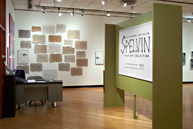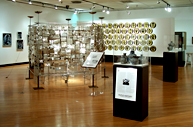THE GEORGE AND HELEN SPELVIN FOLK ART COLLECTION
Visiting George and Helen Spelvin’s modest yellow split-level house in Lenoir City, Tennessee, is like making a pilgrimage to a sacred temple of American Folk Art. While their neighbors purchased bass boats, home entertainment systems, recreational vehicles, and patio furniture, the Spelvins were quietly amassing a significant collection of contemporary folk art.
In 1998, when the collection outgrew the size of their home and their capacity to maintain it, they donated over 900 works to the Hokes Archives at
the University of Tennessee. Placing the collection the hands of the state’s major research university, they wanted it to “serve as a study collection and teaching tool.” This traveling exhibition offers a significant opportunity to realize this objective.
Any collection of art reflects the taste, values, and ideology of the collectors. Just as the biographical text panels accompanying the work in this exhibition offer stories about each of the artists, the collection as a whole tells us a variety of things about George and Helen Spelvin.
In 1979 the Spelvins met Lucas Farley while searching for land to buy near Roanoke, Virginia. Rather than purchasing property, they ended up convincing Mr. Farley to sell them a collection of his painted records. Farley created the records the previous year following the death of his mother Estella. This purchase sparked the Spelvin’s enthusiasm for folk art. They began spending every summer traveling throughout a six-state region searching for new folk art “discoveries.”
The Spelvins seldom purchased work through art galleries. Instead, they believed it was important to establish relationships with the artists whose work they acquired. As an agent for State Farm Insurance, George Spelvin loved to meet people and had a way of making the artists they encountered feel at ease. However, observers in the field of folk art such as Arthur Blade contend that it was actually Helen Spelvin who was the driving force behind their collecting habits.
Arthur Blade also contends that the obscurity of this collection reflects the modesty of the Spelvins. While most collectors seek to promote the careers of the artists they collect, thus increasing their market share, George and Helen Spelvin were private people of middle class means who quietly admired this art. The appeal of folk art for them is its authenticity. The significance of this exhibition may be found in the purity of intentions of this couple from Lenoir City, Tennessee.
Some common characteristics may be found in these works: many of the pieces show a mastery of representation, an emphasis on portraiture, a strong sense of contrast and design, and a concern with craftsmanship. George believed the universal trait of all art is a commitment to craft. He privileged art which showed discipline and a strong work ethic. Helen shared this philosophy but also chose artists whose work offered moral or spiritual lessons on the power of the individual to cope and overcome adverse conditions.
As an elementary school teacher, Helen believed that artistic creativity is learned by example and that aspects of art could be taught. She disliked the term “Outsider Art,” claiming that many of the artists in their collection play a stronger role in their communities than most academically trained artists.
Helen Spelvin’s belief that art allows its maker to cope and survive is reflected in the theories of Roger Manley. Manley wrote that many folk artists begin making their art after “the loss of a job through illness, injury or retirement; death of a spouse or elderly parent; religious doubt, social ostracism, imprisonment.” He claims that these events precipitate their transformation from “ordinary” farmers, loggers, or textile workers into artists. Many of these late blooming artists measured their self worth through “jobs in which they were able to see a tangible, very physical product or result at the end of each day’s labor.” For several of the artists in the Spelvin collection, the creation of art was a response to such a void in their lives.
The Spelvins made a conscious choice not to collect art by mental patients, social misfits, or sexual criminals. They did not share Jean Dubuffet’s passion for “art brut.” In 1945, seeking an authentic, uncultured art, Dubuffet visited psychiatric hospitals and prisons in Switzerland. There he encountered the work of Adolf Woolfi, as well as the collection of psychotic art owned by Geneva psychiatrist Charles Ladame. These experiences offered a paradigm for Dubuffet’s concept of “Art Brut,” which stressed madness as the quintessence of inventiveness. Although one might contend
that E. B. Hazzard’s “Alien Communication Device” has much in common with “Art Brut,” most of the art prized by the Spelvins was by everyday people who found meaning and self-worth in the making of artistic objects.
Unlike many other folk art collectors, the Spelvins did not consult Herbert W. Hemphill’s Twentieth-Century American Folk Art and Artists(E. P. Dutton, 1974) as a guidebook for their collecting practices. Their collection, then, has very few works by Edgar Tolson, S. P. Dinsmoor, Joseph Yoakum, Minnie Evans and other folk artists who have been recognized as classic examples of the field. Other than the work of Lester Dowdey and Emma Whorley, this collection is comprised of work by artists who are mostly unknown.
It is remarkable that a group of artists of this magnitude could be unknown to most folk art collectors and curators. Yet, the field of folk art is uncovering new artists all of the time. The architectural draftsman Achillies Rizzoli, who created elaborate drawings depicting a utopian world, which were found in the ceiling rafters of a San Francisco home, is an example of such a discovery. Likewise, the national tour of this collection has the potential to be the major folk art story as we begin the new millennium.
Many of the artists in this collection created work only over a brief period, often discontinuing their art production as circumstances in their lives changed. This fact makes this collection especially valuable. Once discovered, much of this art was netted though “sharecropping,” in which the Spelvins acquired the pieces for relatively small payments. This is a common pattern in the provenance of folk art and may
explain the increased critical and curatorial attention given to this field.
Eugene Metcalf and Kenneth Ames have criticized the nostalgic and “rusticophilia” aspects of folk art, which appeal to the cultural elite’s yearning for
“non-modern people, places, experiences, and artifacts with which to have the ‘natural’ and ‘authentic’ relationships that give substance and meaning to their lives.”
The Spelvins certainly fit this stereotype; George is an avid collector of Delta Blues music, and Helen still drives a 1963 Volvo station wagon because of its “simple charm.” Their choice to live in East Tennessee where they maintain a large garden and keep two goats also reflects similar values.
In her brilliant book The Temptation: Edgar Tolson and the Genesis of Twentieth Century Folk Art(University of North Carolina Press, 1998), Julia S. Ardery makes the case that many folk art collectors are motivated by a romantic white liberalism, attempting to reform culture while striving to retain aspects of an “authentic” past. While George and Helen Spelvin’s social values and taste reflect these contradictions, it could also be said that, more than anything else, they learned to love folk art and formed a deep respect for the people who made it. This exhibit offers a record of this affection.
As a school teacher, Helen Spelvin believes that folk art provides lessons on aesthetic intelligence. Helen has observed that every person possesses an innate creative ability that needs to be stimulated by example and honed by experience. In college she read the theories of John Dewey, and as an educator, she made art a regular activity for her third grade students.
She dislikes the term “self-taught” and claims that we all have some creative influence in our lives. She has pointed out that Lester Dowdey’s uncle J. C. Burris made limberjacks, Charlotte Black took art classes in high school, Rufus Martinez was an apprentice to a potter, Juanita Richardson’s father was a sign painter, and Emma Whorley had done needlepoint since she was a child.
The Spelvins were conscious of building a collection that represented a range of materials and processes. Before discovering the work of Rufus Martinez, they made several trips to the Carolinas looking for a potter to add to the collection. The acquisition of Loretta Howard’s “Inter-racial Rag Doll Friendship Chain” resulted from a tireless search for a unique fabric piece. While they did not make an attempt to find a set of velvet paintings, their discovery of Charlotte Black’s “Bride Paintings” offers an example of an art form that is generally ignored by folk art “experts.” George and Helen Spelvin viewed these portraits and Arthur Middleton’s images of United States Presidents as examples of the importance of the individual in American culture.
The Spelvins believed that each work of art resonated its true meaning when paired with similar works by the same artist. This is one reason for the visual continuity in the collection. Although many folk artists create a “production line” of similar works to fulfill market demands, few of the pieces in this collection were ever made for a commercial market. George Spelvin liked the serial nature of the collection because it provided tangible evidence for the value of human labor.
The limited number of sculptural items in the collection reflects the Spelvin’s finite storage capacity. The collection was constantly rotated between their garage, attic, and various walls throughout their modest house. Their decision to donate most of the collection to the Hokes Archives at the University of Tennessee will ensure that it remains intact and allows the work to be seen by a significant audience. This modest document is one effort to realize this objective.

